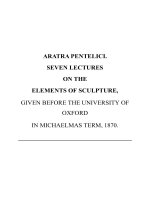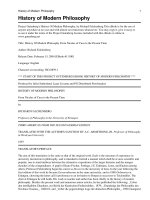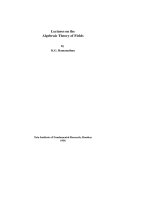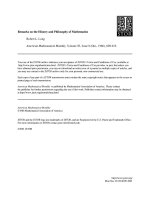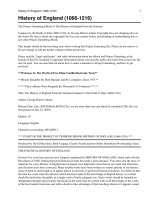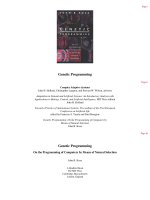Lectures on the history of moral philosophy john rawls
Bạn đang xem bản rút gọn của tài liệu. Xem và tải ngay bản đầy đủ của tài liệu tại đây (3.64 MB, 408 trang )
L H M P
L
H M P
J R
Edited by Barbara Herman
Cambridge, Massachusetts, and London, England
Copyright by the President and Fellows of Harvard College
Printed in the United States of America
Library of Congress Cataloging-in-Publication Data
Rawls, John, –
Lectures on the history of moral philosophy/John Rawls ; edited by Barbara
Herman.
p. cm.
Includes bibliographical references and index.
ISBN --- (alk. paper)—ISBN --- (pbk. : alk. paper)
. Ethics, Modern—th century. . Ethics, Modern—th century.
. Ethics, Modern—th century. I. Herman, Barbara. II. Title.
BJ.R
′.′′—dc
-
C
E’ F
A N T
I: M M P, –
.
.
.
.
.
.
.
A Difference between Classical and Modern Moral Philosophy
The Main Problem of Greek Moral Philosophy
The Background of Modern Moral Philosophy
The Problems of Modern Moral Philosophy
The Relation between Religion and Science
Kant on Science and Religion
On Studying Historical Texts
H
. M P P
. Background: Skepticism and the Fideism of Nature
. Classification of the Passions
. Outline of Section of Part III of Book II
. Hume’s Account of (Nonmoral) Deliberation: The Official View
. R D R R
. Three Questions about Hume’s Official View
. Three Further Psychological Principles
. Deliberation as Transforming the System of Passions
. The General Appetite to Good
. The General Appetite to Good: Passion or Principle?
. J A V
. The Capital of the Sciences
. The Elements of Hume’s Problem
. The Origin of Justice and Property
. The Circumstances of Justice
. The Idea of Convention
Examples and Supplementary Remarks
. Justice as a Best Scheme of Conventions
. The Two Stages of Development
. T C R I
. Introduction
. Some of Clarke’s Main Claims
. The Content of Right and Wrong
. Rational Intuitionism’s Moral Psychology
. Hume’s Critique of Rational Intuitionism
. Hume’s Second Argument: Morality Not Demonstrable
. T J S
. Introduction
. Hume’s Account of Sympathy
. The First Objection: The Idea of the Judicious Spectator
. The Second Objection: Virtue in Rags Is Still Virtue
. The Epistemological Role of the Moral Sentiments
. Whether Hume Has a Conception of Practical Reason
. The Concluding Section of the Treatise
Appendix: Hume’s Disowning the Treatise
L
. H M P
. Introduction
. Leibniz’s Metaphysical Perfectionism
. The Concept of a Perfection
. Leibniz’s Predicate-in-Subject Theory of Truth
. Some Comments on Leibniz’s Account of Truth
[ ]
. S A S: T F
. The Complete Individual Concept Includes Active Powers
. Spirits as Individual Rational Substances
. True Freedom
. Reason, Judgment, and Will
. A Note on the Practical Point of View
K
. G: P P I
. Introductory Comments
. Some Points about the Preface: Paragraphs –
. The Idea of a Pure Will
. The Main Argument of Groundwork I
. The Absolute Value of a Good Will
. The Special Purpose of Reason
. Two Roles of the Good Will
. T C I:
T F F
.
.
.
.
.
.
.
Introduction
Features of Ideal Moral Agents
The Four-Step CI-Procedure
Kant’s Second Example: The Deceitful Promise
Kant’s Fourth Example: The Maxim of Indifference
Two Limits on Information
The Structure of Motives
. T C I:
T S F
.
.
.
.
.
.
.
The Relation between the Formulations
Statements of the Second Formulation
Duties of Justice and Duties of Virtue
What Is Humanity?
The Negative Interpretation
The Positive Interpretation
Conclusion: Remarks on Groundwork II:– (–)
[ ]
. T C I:
T T F
.
.
.
.
.
.
Gaining Entry for the Moral Law
The Formulation of Autonomy and Its Interpretation
The Supremacy of Reason
The Realm of Ends
Bringing the Moral Law Nearer to Intuition
What Is the Analogy?
. T P R O
M L
.
.
.
.
.
.
Introduction
The First Three of Six Conceptions of the Good
The Second Three Conceptions of the Good
Autonomy and Heteronomy
The Priority of Right
A Note on True Human Needs
. M C
. Rational Intuitionism: A Final Look
. Kant’s Moral Constructivism
. The Constructivist Procedure
. An Observation and an Objection
. Two Conceptions of Objectivity
. The Categorical Imperative: In What Way Synthetic A Priori?
. T F R
. Introduction
. The First Fact of Reason Passage
. The Second Passage: §§– of Chapter I of the Analytic
. The Third Passage: Appendix I to Analytic I, Paragraphs –
. Why Kant Might Have Abandoned a Deduction for the
Moral Law
. What Kind of Authentication Does the Moral Law Have?
. The Fifth and Sixth Fact of Reason Passages
. Conclusion
[ ]
. T M L L F
. Concluding Remarks on Constructivism and Due Reflection
. The Two Points of View
. Kant’s Opposition to Leibniz on Freedom
. Absolute Spontaneity
. The Moral Law as a Law of Freedom
. The Ideas of Freedom
. Conclusion
. T M P R,
B I
.
.
.
.
.
The
The
The
The
The
Three Predispositions
Free Power of Choice
Rational Representation of the Origin of Evil
Manichean Moral Psychology
Roots of Moral Motivation in Our Person
. T U R
. The Practical Point of View
. The Realm of Ends as Object of the Moral Law
. The Highest Good as Object of the Moral Law
. The Postulates of Vernunftglaube
. The Content of Reasonable Faith
. The Unity of Reason
H
. H R
. Introduction
. Philosophy as Reconciliation
. The Free Will
. Private Property
. Civil Society
. E L L
. Sittlichkeit: The Account of Duty
. Sittlichkeit: The State
[ ]
. Sittlichkeit: War and Peace
. A Third Alternative
. Hegel’s Legacy as a Critic of Liberalism
A : C O
I
[ ]
E’ F
There is little doubt that modern political philosophy was transformed in
with the publication of John Rawls’s A Theory of Justice. Its questions and
method, its manner of argumentation and its range of topics, set an agenda
for social and political philosophy in the last quarter of the past century and
into this one. But John Rawls’s contribution to philosophy is not to be measured solely in terms of the impact of A Theory of Justice and related published
work. As a professor at Harvard from until , he had a profound
influence on the approach to philosophical ethics of many generations of
students, and through them, on the way the subject is now understood. In
particular, his teaching conveyed an unusual commitment to the history of
moral philosophy. At the center of his thought about this history is the idea
that in the great texts of our tradition we find the efforts of the best minds to
come to terms with many of the hardest questions about how we are to live
our lives. Whatever their flaws, superficial criticism of these texts is always
to be resisted; it is without serious point. If in studying these figures one thinks
about what their questions were, and how they saw their work as responsive
to worries that might not be our own, a fruitful exchange of ideas across the
centuries is possible. Rawls’s lectures at Harvard offered a compelling example
of just how much could be learned through such an engagement. Although
it is obvious throughout his published work that the history of philosophy
matters greatly to him, very little of the extraordinary product of his life-
’
long study of this history is known. The present volume of Rawls’s lectures
on the history of moral philosophy aims to make widely available this important part of his philosophical accomplishment.
In his thirty years at Harvard, Rawls offered a variety of courses in moral
and political philosophy. The one that had the greatest impact was the
course he thought of as his introductory undergraduate course on ethics.
Prior to , it surveyed a mix of historical figures, usually including Aristotle, Kant, and Mill, but sometimes also Hume or Sidgwick or Ross. The
course was sometimes called Ethics, sometimes Moral Psychology. As
Rawls taught it, moral psychology was not an academic subfield of ethics,
but rather the study of the role of a moral conception in human life: how
it organizes moral reasoning, the conception of a person that it presupposes,
and the social role of the moral conception. Along with a substantive account of the right, it completed the practical part of a moral conception,
and often contained its most distinctive contribution.
The broad plan for the course involved delineating four basic types of
moral reasoning: perfectionism, utilitarianism, intuitionism, and Kantian
constructivism. Views from historical texts were set out within these rubrics
with an eye to providing answers to such questions as: How do we deliberate—rationally and morally? What is the connection between principles of
belief and motives? What are the first principles, and how do we come to
desire to act on them? Essential to an adequate response was always an
account of a moral conception’s social role. Rawls held that the idea of
social role is often wrongly restricted to finding principles for adjudicating
competing claims. The wider examination of social role involves considering how and whether a moral conception can be an essential part of a
society’s public culture—how it supports a view of ourselves and each other
as rational and reasonable persons. These were the kind of questions Rawls
thought moral philosophy, as a branch of philosophy with its own methods,
was in a position to answer. Other sorts of questions—about realism or
about meaning, for example—were neither best investigated by moral philosophy nor necessary for making progress in the areas of moral philosophy’s distinctive problems.1
1. See John Rawls, “The Independence of Moral Theory,” in John Rawls: Collected Papers (Cambridge, Mass.: Harvard University Press, ).
[ ]
’
In the mid-s the course changed, and Rawls began to focus primarily
on Kant’s ethical theory. The change coincided with the period of work
leading up to his Dewey Lectures (“Kantian Constructivism in Moral
Theory,” delivered at Columbia University), in which Rawls was concerned
to “set out more clearly the Kantian roots of A Theory of Justice,” and to
elaborate the Kantian form of constructivism, whose absence from the
scene, he thought, impeded “the advance of moral theory.”2 The first time
he taught the new Kant material was in a graduate seminar (in spring )
on Kant on the topic of Moral Goodness, and in spring , Rawls delivered
the first series of his “Kant lectures.”
About a week and a half into the lecture course, Rawls took pity on
the graduate and undergraduate students frantically trying to take verbatim
notes, and offered to make his lectures available to anyone who wanted
them. Copies of the first batch of handwritten notes cost cents. Rawls’s
unpublished work had often circulated among students and friends. Either
he made it available himself or, as in the s, graduate student teaching
assistants prepared and distributed “dittos” of their course notes. Starting
in , Rawls took on the regular task of preparing and updating the Kant
lectures as part of the materials for his course. These lecture notes acquired
something of a life of their own, passed on from one generation of Rawls’s
students to their own students elsewhere. The lectures in this volume are
from the last offering of the course, in .
The lectures went through major revisions in , , and . (In
between these years, versions would be amended and corrected, but remained substantially the same.) The organizing principle of the first version
of the lectures was an interpretation of Kant’s Groundwork for the Metaphysics
of Morals. Eight of ten lectures were about the Groundwork; there was, in
addition, an introductory lecture, sometimes about intuitionism, sometimes
about Sidgwick, moral psychology, and constructivism, and a tenth lecture
on the Fact of Reason. In discussing the Groundwork, Rawls paid considerable attention to the formulas of the categorical imperative and the wellknown difficulties with it as a procedure for moral judgment. In the mids, Rawls added lectures on Hume and Leibniz (four on Hume, two on
2. John Rawls, “Kantian Constructivism in Moral Theory: The Dewey Lectures, ,” Journal
of Philosophy , (), .
[ ]
’
Leibniz), and the content of the Kant lectures underwent a shift into roughly
their current form, with only four lectures on the Groundwork, and six
other Kant lectures on the Priority of Right, Constructivism, the Fact of
Reason, Freedom, the moral psychology of Religion within the Limits of Reason Alone, and the Unity of Reason. In a lecture on Justice as an Artificial
Virtue became the fifth Hume lecture, and two lectures on Hegel were
added (though Rawls produced no version of the Hegel lectures for distribution).3
Two ideas figured prominently in Rawls’s rethinking of the Kant lectures. One was that too intense a focus on the Groundwork and its collection
of interpretive issues gave a distorted picture of Kant’s contribution to moral
theory. Many central notions were present only in the Critique of Practical
Reason, Religion within the Limits of Reason Alone, and the Doctrine of Virtue.
In addition, Rawls came to believe that negotiating the details of the categorical imperative procedure didn’t matter nearly as much as understanding
what such a procedure was about—namely, how Kant thought a formal
procedure could model a noninstrumental conception of rationality. The
second large decision was to take up the subjects of freedom and Kant’s
constructivist solution to foundational questions.4 Here, Rawls argues, the
Groundwork has neither the last word nor always the best. This shift in
emphasis in the Kant lectures partly motivates the inclusion of lectures on
Leibniz. Leibniz was the dominant figure in German philosophy in Kant’s
time, and where Kant’s concerns touch those of Leibniz, even when Kant
developed his own distinctive views, “the fact remains that Leibniz’s ideas
often shape Kant’s mature doctrine in striking and subtle ways” (Leibniz
I, §). This is particularly so with Leibniz’s philosophical reconciliation of
faith and reasonable belief, his perfectionism, and his view of freedom. For
Rawls, to understand Kant’s constructivism in a serious way, one has to
3. The Hegel lectures in this volume were compiled by the editor from Rawls’s notes for those
classes, and from some partial notes for lectures in his political philosophy course. Rawls read
through them in and made some changes. Given Rawls’s long-standing interest in Hegel, to
have in print even a little of his view of Hegel’s contribution to moral philosophy seemed to warrant
the editorial license.
4. The new focus is evident in Rawls’s one published piece on Kant’s ethics: “Themes in Kant’s
Moral Philosophy,” in Kant’s Transcendental Deductions, ed. Eckart Fo¨rster (Stanford: Stanford University Press, ).
[ ]
’
appreciate with some historical specificity the strengths and weaknesses of
the rationalist thought of his day.
An extended discussion of Hume, especially of Book II of the Treatise
of Human Nature, was always a part of the Kant lectures. While it is common
to compare Kantian and Humean moral psychology (one as the foil for the
other), the view of Hume in such comparisons tends to be superficial: passions as original existences and the sources of our interests and ends, the
purely instrumental role of reason, and so forth. Rawls, by contrast, looks
closely and at length at Hume’s moral psychology (with special attention
to Hume’s criticisms of rational intuitionism), carefully eliciting from the
text of the Treatise a rich and layered Humean account of deliberation and
practical reasoning. It is a Humean view that is both powerful and resourceful. Nevertheless, Rawls makes it clear just what the limits of the Humean
desire-based account of deliberation are, motivating the idea, central to
Kant’s rationalist moral psychology, of principle-dependent desires as essential to an account of practical reason (see Hume II, §).
The rationale for the inclusion of Hegel in a series of lectures focused
on Kant is obvious: Hegel’s criticisms of Kant’s ethics set the terms of Kant
interpretation for more than years. But Rawls’s chief interest in Hegel
was not to rebut his criticisms (by itself, for Rawls, that would probably
not be enough; the careful reading of Kant would be sufficient). It is Hegel’s
notion of Sittlichkeit that interests Rawls; it is the idea that allows Hegel to
elaborate the notion of a wide social role for morality (and for moral philosophy) first broached in Kant’s ethical and political writings. In a sense, the
Hegel lectures sketch the bridge between Kantian moral thought and the
liberalism of Rawls’s own work: the view of persons as “rooted in and
fashioned by the system of political and social institutions under which they
live” (Hegel I), the place of religion in secular society, and the role of philosophy in public ethical life. Unlike many, Rawls reads Hegel as a part of the
liberal tradition, and his reading of Hegel helps us to see what the complete
shape of that tradition is. Certainly, in reading the Hegel lectures one gets
a full measure of Rawls’s method of reading historical texts. It does not
matter that one view or another may seem to us wrongheaded if there is
something to be learned from understanding why a philosopher of the first
order would advance it.
[ ]
’
About his aims and method in presenting a philosophical text to students, no one is more eloquent than Rawls himself. In he wrote a
marvelous description of his teaching. It occurs near the end of a reminiscence about his friend and colleague Burton Dreben.
When lecturing, say, on Locke, Rousseau, Kant, or J. S. Mill, I always
tried to do two things especially. One was to pose their problems as
they themselves saw them, given what their understanding of these
problems was in their own time. I often cited the remark of Collingwood that “the history of political theory is not the history of different
answers to one and the same question, but the history of a problem
more or less constantly changing, whose solution was changing with
it.”5 . . . The second thing I tried to do was to present each writer’s
thought in what I took to be its strongest form. I took to heart Mill’s
remark in his review of [Alfred] Sedgwick: “A doctrine is not judged
until it is judged in its best form.”6 I didn’t say, not intentionally anyway, what I myself thought a writer should have said, but rather what
the writer did say, supported by what I viewed as the most reasonable
interpretation of the text. The text had to be known and respected, and
its doctrine presented in its best form. Leaving aside the text seemed
offensive, a kind of pretending. If I departed from it—no harm in
that—I had to say so. Lecturing that way, I believed, made a writer’s
views stronger and more convincing, and a more worthy object of
study.
I always took for granted that the writers we were studying were
much smarter than I was. If they were not, why was I wasting my
time and the students’ time by studying them? If I saw a mistake in
their arguments, I supposed those writers saw it too and must have
dealt with it. But where? I looked for their way out, not mine. Sometimes their way out was historical: in their day the question need not
be raised, or wouldn’t arise and so couldn’t then be fruitfully discussed.
Or there was a part of the text I had overlooked, or had not read.
5. R. G. Collingwood, An Autobiography (Oxford: Clarendon Press, ), p. .
6. In Mill’s Collected Works, vol. , Essays on Ethics, Religion, and Society, ed. J. M. Robson
(Toronto: University of Toronto Press, ), p. .
[ ]
’
I assumed there were never plain mistakes, not ones that mattered
anyway.
In doing this I followed what Kant says in the Critique of Pure Reason
at B, namely that philosophy is a mere idea of a possible science and
nowhere exists in concreto: “[W]e cannot learn philosophy; for where is
it, who is in possession of it, and how shall we recognize it? We can
only learn to philosophize, that is, to exercise the talent of reason, in
accordance with its universal principles, on certain actually existing
attempts at philosophy, always, however, reserving the right of reason
to investigate, to confirm, or to reject these principles in their very
sources.” Thus we learn moral and political philosophy—or indeed
any part of philosophy—by studying the exemplars, those noted figures
who have made cherished attempts at philosophy; and if we are lucky,
we find a way to go beyond them. . . .
The result was that I was loath to raise objections to the exemplars;
that’s too easy and misses what is essential. However, it was important
to point out difficulties that those coming later in the same tradition
sought to overcome, or to point to views those in other traditions
thought were mistaken. . . .
With Kant I hardly made any criticisms at all. My efforts were
centered on trying to understand him so as to be able to describe his
ideas to the students. Sometimes I would discuss well-known objections to his moral doctrine, such as those of Schiller and Hegel, Schopenhauer and Mill. Going over these is instructive and clarifies Kant’s
view. Yet I never felt satisfied with the understanding I achieved of
Kant’s doctrine as a whole. I never could grasp sufficiently his ideas
on freedom of the will and reasonable religion, which must have been
part of the core of his thought. All the great figures . . . lie to some
degree beyond us, no matter how hard we try to master their thought.
With Kant this distance often seems to me somehow much greater.
Like great composers and great artists—Mozart and Beethoven, Poussin and Turner—they are beyond envy. It is vital in lecturing to try
to exhibit to students in one’s speech and conduct a sense of this, and
why it is so. That can only be done by taking the thought of the text
seriously, as worthy of honor and respect. This may at times be a
[ ]
’
kind of reverence, yet it is sharply distinct from adulation or uncritical
acceptance of the text or author as authoritative. All true philosophy
seeks fair criticism and depends on continuing reflective public judgment.7
Rawls never intended that his lectures be published. As he saw things,
they were not serious works of scholarship, but were aimed at helping his
students and himself to understand and appreciate the thought of a set of
important figures in the history of moral philosophy, most prominently
Kant. Too many questions remained unanswered, too much was obscure
for them to be of value to anyone, he often said. It was only after many
years of resistance that he finally agreed to let the project go forward. In
the end, he was moved by two considerations. The first was the unfairness
that some but not all who might benefit from the lectures had access to
them. If you were not a friend of a friend of someone who studied ethics
at Harvard, you would not have them. And second was the fact of the
multiple generations of the lectures. However imperfect Rawls thought the
last version was, since he also thought the lectures had improved over time,
it was important that the version that would survive be the best. His own
past generosity in distributing the lectures to generations of his students
guaranteed that one or more of the older sets of the lectures would continue
to circulate. When he agreed to let the lectures be published, Rawls did so
on the condition that their format not be changed: they were to remain
lectures, that is, retain the style and voice of the pages distributed to students.
The editorial work on the lectures has, accordingly, been minor. Apart from
sorting out obscure abbreviations, checking quotations, and cleaning up
some of the inevitable roughness of a teaching manuscript, the lectures have
been left as Rawls distributed them in .8 They are offered to students of
the subject in the spirit of an earlier generation of scholarship—where the
best teaching was more commonly preserved alongside the best finished
work.
*
*
*
7. John Rawls, “Burton Dreben: A Reminiscence,” in Juliet Floyd and Sanford Shieh, eds.,
Future Pasts: Perspectives on the Place of the Analytic Tradition in Twentieth-Century Philosophy (New
York: Oxford University Press, 2000).
8. Except, that is, for the two Hegel lectures.
[ ]
’
Textual citations throughout the lectures are given in the running text.
There is one major idiosyncrasy in the method of citation to Kant’s Groundwork for the Metaphysics of Morals. It is now standard scholarly practice to
give textual citations to the relevant volume and page of the Prussian Academy edition of Kant’s collected writings. The practice is followed for citations to all of Kant’s work other than the Groundwork. For the Groundwork,
the lectures continue Rawls’s teaching practice of referring to parts of the
text by chapter and paragraph number (e.g., Gr I: is the fourth paragraph
of the first chapter of the Groundwork). The Academy number (to Volume
) follows in brackets (so, Gr I: []). Although this sometimes makes for
a page cluttered with numbers, since Rawls discusses arguments as they
develop in a series of paragraphs, there is no way to avoid it. (In his courses,
Rawls used the chapter and verse system for the Groundwork and for J. S.
Mill’s Utilitarianism.) Those who plan to work closely with the Kant lectures
should follow Rawls’s instructions to his students to prepare their copy of
the Groundwork for study by numbering the paragraphs, starting again with
“” at the beginning of each chapter.
Translations for the most part follow the editions Rawls used for teaching. Some departures seemed clearly to be errors in transcription, and these
were corrected. In other cases, most often in passages from the Critique of
Practical Reason, it was clear that Rawls had changed the translation deliberately; these have been kept.
For help with editing and preparing the manuscript, thanks to Glenn
Branch, Amanda Heller, and Donna Bouvier; thanks also to Ben Auspitz
for the index.
[ ]
A N T
Unless otherwise indicated, Kant’s works will be cited by volume and page
of the Gesammelte Schriften, usually called the Akademieausgabe. This edition
was first published starting in by the Prussian Academy of Sciences.
Citations to the Groundwork are by chapter and paragraph as well as Akademie page of Volume ; citations to the Critique of Pure Reason are in the
customary first- and second-edition pagination.
Gr Groundwork of the Metaphysics of Morals, trans. H. D. Paton
(New York: Harper and Row, )
KP Critique of Practical Reason, trans. L. W. Beck (Indianapolis:
Bobbs-Merrill, )
KR Critique of Pure Reason, trans. N. Kemp Smith (New York:
St. Martin’s Press, )
KU Critique of Judgment, trans. J. C. Meredith (Oxford: Oxford
University Press, )
MdS Metaphysics of Morals, pt. , trans. M. Gregor as The Doctrine of Virtue (New York: Harper and Row, )
Rel Religion within the Limits of Reason Alone, trans. T. M.
Greene and H. H. Hudson (New York: Harper and Row,
)
Other texts:
David Hume, Enquiry Concerning the Principles of Morals (ϭ E ),
ed. L. A. Selby-Bigge (Oxford: Oxford University Press, )
David Hume, Treatise of Human Nature (ϭ T ), ed. P. H. Nidditch (Oxford: Oxford University Press, )
G. W. Leibniz, Philosophical Essays, ed. Roger Ariew and Daniel Garber (Indianapolis: Hackett, )
G. W. F. Hegel, Elements of the Philosophy of Right (ϭ PR),
trans. H. B. Nisbet, ed. A. W. Wood (Cambridge: Cambridge University Press, )
[ ]
L H M P
I: M M P, –
§. A Difference between Classical and Modern Moral Philosophy
. I begin with an apparent difference between classical and modern moral
philosophy. By classical moral philosophy I mean that of ancient Greece,
mainly of Athens or of the philosophers who lived there, Socrates, Plato,
and Aristotle, and members of the Epicurean and Stoic schools. By modern
moral philosophy I mean that of the period from to , but we
should include sixteenth-century writers such as Montaigne, who were major influences later on.
When Sidgwick comes in Book I of the Methods of Ethics to the concept
of good, he remarks that until then he has been discussing rightness, which
is, he says, the concept frequently used by English writers. He has treated
this concept and its equivalents as implying a dictate, or an imperative, of
reason. Reason is seen as prescribing certain actions unconditionally, or else
with reference to some ulterior end. Yet it is possible, Sidgwick says, to see
the moral ideal as attractive, as specifying an ideal good to be pursued,
rather than as a dictate, or an imperative, of reason. Virtuous action, or
rightness in action, is seen not as a dictate of an imperative reason, but as
something good in itself, and not merely as a means to some ulterior good.
Sidgwick thinks that such was the fundamental ethical view of the Greek
schools of moral philosophy:
The chief characteristics of ancient ethical controversy as distinguished
from modern may be traced to the employment of a generic notion
[of good] instead of a specific one [such as rightness] in expressing
[ ]
